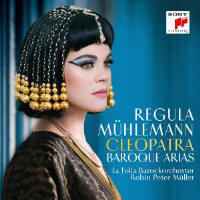Texte paru dans: / Appeared in: |
|
|
Outil de traduction (Très approximatif) |
|
|
Reviewer:
David Vickers
The conceptual dressing-up as an Egyptian for the cover photo is also very similar to Bayrakdarian – but otherwise Mühlemann presents a more eclectic survey that takes in extracts from Sartorio’s Giulio Cesare in Egitto (Venice, 1676), part of a chamber cantata by Alessandro Scarlatti and two other different historical Cleopatras depicted in a delicate continuo aria from Legrenzi’s Antioco (Venice, 1681) and an agitated juxtaposition of defiance and lament from Vivaldi’s portion of the multi-authored but mostly lost Il Tigrane (Rome, 1724). The washy sound recording, made in an old bathhouse in Annaberg-Buckholz, requires some acclimatisation and does not flatter La Folia in quick music – the orchestral turbulence in Hasse’s ‘Morte, col fiero aspetto’ suffers from a lack of clarity – but Mühlemann’s seemingly effortless virtuosity is displayed admirably in Graun’s ‘Tra le procelle assorto’, whereas her melodic singing in Handel’s ‘Se pietà’ is as profoundly moving as any of the most distinguished sopranos to have tackled it on disc. Hasse’s long scene for Cleopatra resolving upon suicide after the loss of Mark Anthony (‘Quel candido armellino’) is sung with crystalline beauty, whereas Mattheson’s more concise depiction of the same event (‘Ruhe sanft, geliebter Geist’) has touching intimacy and melancholy – although its solo harp accompaniment might be post-historical alternative fact. |
|




